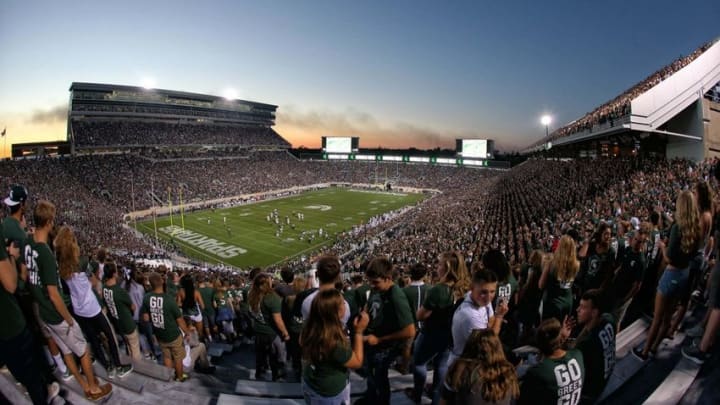Michigan State had claimed the Megaphone in 11 of 12 matchups with Notre Dame since Leahy’s departure after the 1949 season and won the national championship in 1952. In Parseghian’s first year in South Bend, the Irish trounced the Spartans 34-7. The Spartans won the return match in 1965, 12-7, conceding only 12 yards to the Irish.
In 1966, the Spartans were coming off a 10-1 season which included a Big Ten championship and a Rose Bowl appearance. They rolled over nearly all of their opponents with ease as the AP Poll went back and forth on whether or not they were the number-one or number-two team in the nation. The Irish were even more dominant, leading the nation in scoring, shutting out five opponents and conceding only 28 points the entire season before their visit to East Lansing.
The teams were filled with a bevy of stars, including ten first-round draft picks, 25 All-Americans and 31 future pros. “If you look at the talent on those two rosters, I don’t know that it will be ever be duplicated,” Notre Dame quarterback Terry Hanratty said. “It was amazing. In that era, those were the two greatest teams to play each other.”
The Big Ten had a rule at the time that prevented a team from going to the Rose Bowl in consecutive years, so this would be the final game of their season for Michigan State. The Irish had not participated in postseason play since the days of Rockne but had their own kind of Rose Bowl coming up: a date in Pasadena with Southern California the next week.
More from Michigan State Spartans
- Betting Preview: Best Bets for Michigan vs. Michigan State
- Michigan State basketball earns no. 7 seed, will play Davidson
- Jayden Reed returning to Michigan State football is huge news
- Peach Bowl: Michigan State football betting odds and prediction
- Michigan State football’s Kenneth Walker III snubbed from popularity contest
There was a third team that was trying to crash the national championship part in 1966. Returning national champion Alabama had been ranked number-one by the AP before the season but had slipped to third despite running the table, perhaps due to the fact that the team was all-white, which was controversial in the era of the Civil Rights Movement.
Michigan State, on the other hand, was a bastion of diversity. 17 players, including 12 of the team’s 22 starters, were black, including starting quarterback Jimmy Raye and four of the top eight picks in the 1967 NFL Draft: Bubba Smith, Clinton Jones, George Webster and Gene Washington. The Irish, by contrast, had only one African-American player on their roster: future NFL MVP defensive tackle Alan Page.
The Spartans had a history of integration in the football program. As early as 1913, Gideon Smith had become one of college football’s first black players. In 1950, the aptly-named Willie Thrower became the first black quarterback in the Big Ten and quarterbacked the Spartans to a national championship in 1952.
Michigan State head coach Duffy Daughterty was intentional about bringing in African-American players, especially from the south. Fullback Bob Apisa said, “Duffy did not see color or creed, he saw players. He saw talent.”
“Everything was completely segregated in Texas, how we lived and how we played,” running back Gene Washington said. “All of a sudden, I’m in a friendly atmosphere. I had no problems. It was just a great, great welcoming.”
However, Michigan State’s relatively inclusive atmosphere came with a perceived cost in national polls. As the clock began to wind down on the season that Saturday, Spartan All-American defensive lineman Bubba Smith desperately called out, “Do you think we’re going to win the national championship even if they run the clock out? We got too many n****rs on this team to win the national championship. We have to find a way.”
